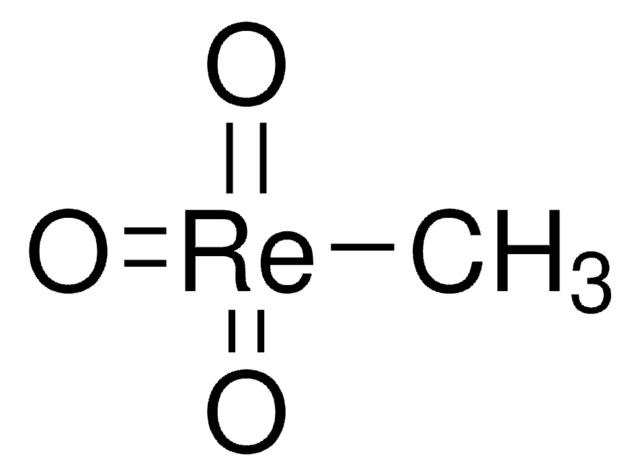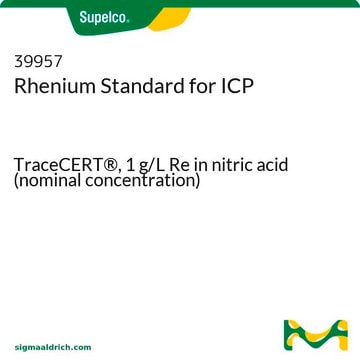316954
Ammonium perrhenate
≥99%
Sinonimo/i:
Metaperrhenic acid ammonium salt, Rhenium standard solution
Scegli un formato
Scegli un formato
About This Item
Prodotti consigliati
Grado
for analytical purposes
Saggio
≥99%
Stato
powder or crystals
Impiego in reazioni chimiche
reagent type: catalyst
core: rhenium
Densità
3.97 g/mL at 25 °C (lit.)
Stringa SMILE
N.O[Re](=O)(=O)=O
InChI
1S/H3N.H2O.3O.Re/h1H3;1H2;;;;/q;;;;;+1/p-1
XPSXHXWHJAIQJR-UHFFFAOYSA-M
Cerchi prodotti simili? Visita Guida al confronto tra prodotti
Categorie correlate
Descrizione generale
Applicazioni
- As a rhenium source to prepare Re nanoparticles for catalytic decomposition of ammonium perchlorate.
- To synthesize ReS2 through a direct sulfidation reaction, for the fabrication of field effect transistors (FETs), digital logic devices, humidity sensors, and rechargeable supercapacitors.
- As a precursor to prepare the heterogeneous catalysts for organic transformations.
- An excellent precursor for the fabrication of ReOx/TiO2 recyclable solidcatalyst for deoxydehydration. For at least six runs in a row, the catalyst demonstrated catalyticactivity, selectivity, and stability without deactivation.
Codice della classe di stoccaggio
13 - Non Combustible Solids
Classe di pericolosità dell'acqua (WGK)
WGK 1
Punto d’infiammabilità (°F)
Not applicable
Punto d’infiammabilità (°C)
Not applicable
Dispositivi di protezione individuale
Eyeshields, Gloves, type P3 (EN 143) respirator cartridges
Scegli una delle versioni più recenti:
Certificati d'analisi (COA)
Non trovi la versione di tuo interesse?
Se hai bisogno di una versione specifica, puoi cercare il certificato tramite il numero di lotto.
Possiedi già questo prodotto?
I documenti relativi ai prodotti acquistati recentemente sono disponibili nell’Archivio dei documenti.
I clienti hanno visto anche
Active Filters
Il team dei nostri ricercatori vanta grande esperienza in tutte le aree della ricerca quali Life Science, scienza dei materiali, sintesi chimica, cromatografia, discipline analitiche, ecc..
Contatta l'Assistenza Tecnica.











